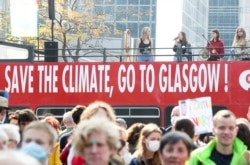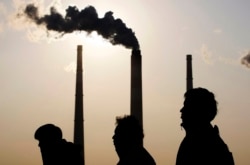In the run-up to the 26th United Nations Climate Change Conference of the Parties (COP26) in Glasgow, Scotland, the goal of keeping global warming within a rise of 1.5 degrees Celsius (2.7 Fahrenheit) remains front and center. That, experts hope, will prevent the most catastrophic changes to the climate and global economy.
As China emits more greenhouse gases than all industrialized nations in the world, Beijing’s role in cutting emissions is viewed as key to hitting that target.
On October 27, China released a white paper, "Responding to Climate Change: China's Policies and Actions.”
According to the Communist Party-run Global Times newspaper, the white paper outlines “China’s target of achieving peak emissions by 2030 and carbon neutrality by 2060,” which it says would represent “the world's highest reduction in carbon emission intensity and the shortest time in achieving the goal of going from carbon peak to carbon neutrality in global history.”
Ye Min, vice minister of ecology and environment, introduced the white paper at a news conference in Beijing. He said China was well on its way to getting a handle on its greenhouse gas emissions, including carbon dioxide (CO2).
“Greenhouse gas emissions have effectively been put under control in 2020. China’s carbon emission intensity [was] reduced by 18.8 percent compared to 2015 and 48.4 percent lower than 2005, exceeding the 40 to 45 [percent] promised to the international community, and basically reversing the rapid growth of CO2 emissions,” Ye said.
Ye’s selective use of statistics is highly misleading. That’s because carbon emission “intensity” is not the same thing as overall carbon emissions. In fact, China’s emissions continue to grow. (CO2 is the main greenhouse gas. Along with others, it traps atmospheric heat and pushes up global temperatures.)
According to Australia’s Climate Council, a nonprofit advocating for greenhouse gas cuts, emission intensity only describes the volume of emissions per unit of gross domestic product (GDP), not a reduction in overall emissions.
That means that with a growing economy, China can actually increase its greenhouse gas emissions even as emission intensity declines.
Based on data released by independent analysts, China did just that last year.
The Climate Council noted that developed countries, including the United States, are aiming for “absolute emission reduction targets reflecting their intent to reduce their total emissions.”
In April, the White House announced it was targeting up to a 52% reduction in net greenhouse gas pollution in 2030, compared to 2005 levels. (The U.S. government defines net emission as “gross emissions, including all industrial activities, minus carbon sinks - natural systems that absorb more carbon from the atmosphere than they release - from forestry activities and agricultural soils.”)
In May, Lauri Myllyvirta, a lead analyst at the Center for Research on Energy and Clean Air (CREA) in Helskinki, wrote that China’s CO2 emissions had grown 15 percent year-on-year in the first quarter of 2021, “their fastest pace in more than a decade.”
Citing official government figures, Myllyvirta said that “CO2 surge” reflected both a post COVID-19 rebound from lockdowns in early 2020, as well as an economic recovery that had “been dominated by growth in construction, steel and cement.”
Ye’s boast that greenhouse gas emissions were “effectively put under control in 2020” is highly dubious.
According to the independent researcher Rhodium Group, China was the only major economy to experience greenhouse gas emissions growth in 2020.
The group, which specializes in India and China, noted that China’s estimated 1.7 percent gas emissions hike for the year was lower than the 3.3 percent average growth over the past decade. Still, it remains a “worrying sign” that the world’s largest emitter’s “focus on a fossil-fueled industrial recovery is at odds with its long-term goal of reaching net-zero emissions by 2060,” Rhodium said.
In a separate analysis, Myllyvirta found that China’s carbon dioxide emissions had grown more than 4%” in the second half of 2020.
By contrast, the National Bureau of Statistics of China reported that carbon intensity fell 1% year-on-year in 2020, Reuters reported.
An analysis in Bloomberg News said China’s economic growth target of 6 percent for 2021 — a figure some believe is low given the lower baseline in 2020 — may be at odds with its plans to cut CO2. The story was titled, “China’s Dirty Recovery Will Make Curbing Climate Change Tougher.”
“Keeping economic growth and stable employment as a priority in the short term will mean further growth in emissions,” Bloomberg cites Yan Qin, carbon analyst at Refinitiv Carbon, as saying.
“Higher emissions in 2021 and the next years will lift up the bar for China to achieve an emissions peak before 2030, requiring more strict measures to be implemented later on.”
The United States has also faced criticism for being the world’s largest greenhouse gas emitter in historical terms, while sitting out on multilateral efforts to address climate change.
Decades of efforts to cut emissions were thwarted, with the oil and gas industry actively sowing disinformation to undermine climate science. As noted in a recent report by National Public Radio (NPR), scientists argue that emission cuts made over the last 15 years have not been enough.
China has seized on that fact to argue that historical polluters like the United States and other European countries should shoulder a larger share of the burden in cutting emissions.
In August, the former U.S. special envoy for climate change, Todd Stern, said China’s plans for the 2020s were not doing enough to meet the goal of capping global warming at 1.5 degrees Celsius.
“Peaking (carbon emissions) by 2030 in China cannot get the job done, and I don’t think it represents a best effort to hold to 1.5 degrees Celsius,” the Associated Press cites Stern as saying. “Nor is China’s substantial planned expansion of its coal fleet in its 14th Five-Year Plan compatible with what needs to happen.”
In February, Global Energy Monitor, a U.S. research institution, and CREA said that China had launched 38.4 gigawatts (GW) of new coal-fired power capacity, the Reuters news agency reported.
That is more than three times the new plant capacity built in the rest of the world.
China made a net gain of 29.8 GW (when factoring in decommissions). The rest of the world, by contrast, cut coal-fired capacity by 17.2 percent.
Myllyvirta argues the expansion of coal is not even necessary.
"The runaway expansion of coal-fired power is driven by electricity companies' and local governments' interest in maximizing investment spending, more than a real need for new capacity,” Reuters cites him as saying.
China saw its 2019 greenhouse gas emissions – including CO2, methane, nitrous oxide, F-gases and sulphur hexafluoride – reach about 27% of the global total, Polygraph.info previously reported, citing a May 2021 report from Rhodium Group.
Between 2000 to 2018, coal accounted for about 75.5 percent of China’s CO2 emissions. China also accounts for half of global coal consumption and is the world’s top producer of coal.
A March 2020 report by Global Energy Monitor, the Sierra Club, Greenpeace and CREA found that China’s coal-powered capacity of 1,095 GW is roughly half of global capacity. China is also responsible for 41 percent of global coal power capacity under construction.
China has argued its economic development should not be hindered by environmental protections, as the United States and other developed countries did not face such restrictions on their developmental paths.
The United Nations warns the world may be headed for a 2.7-degree Celsius rise by the end of the century even if current commitments are met.









